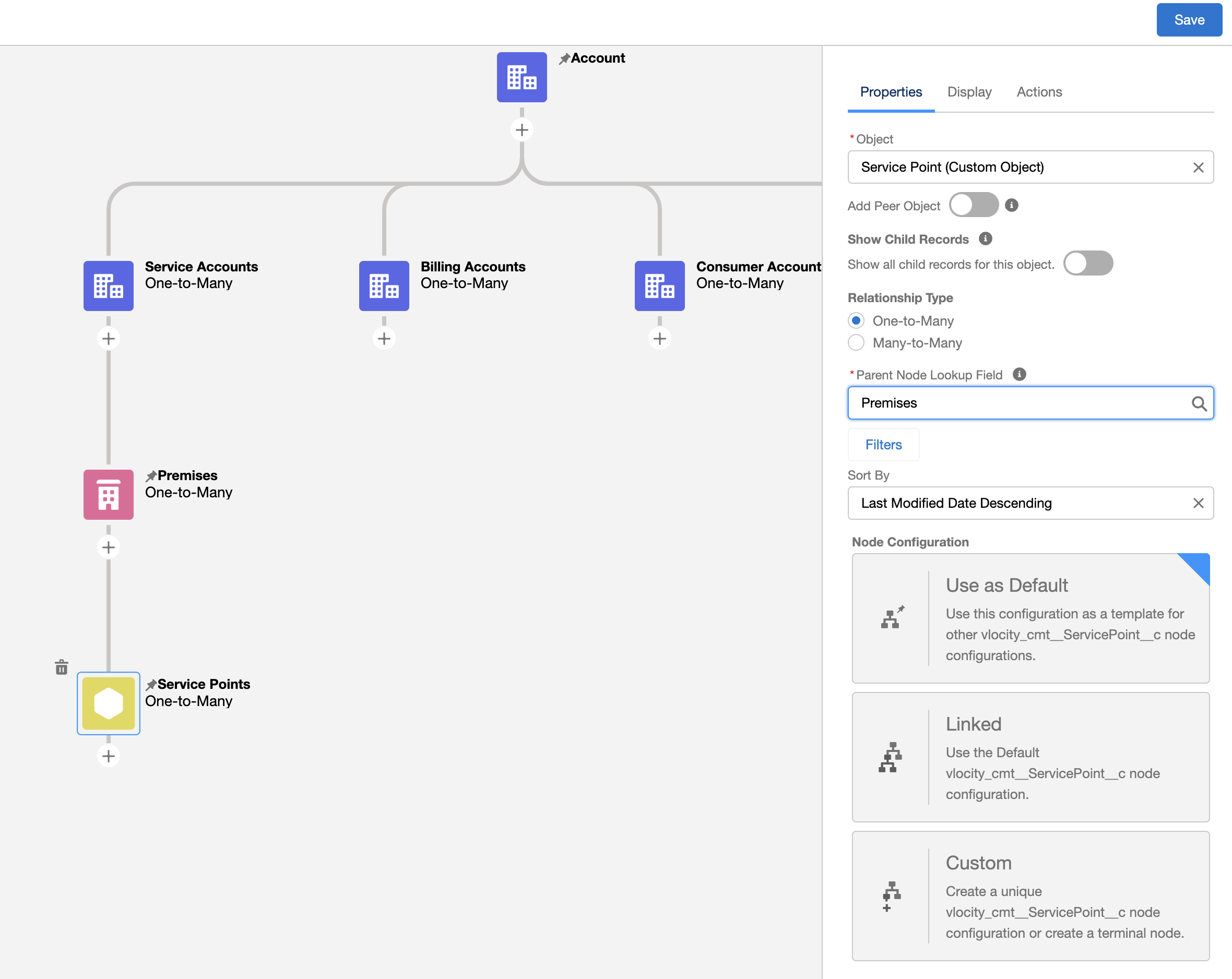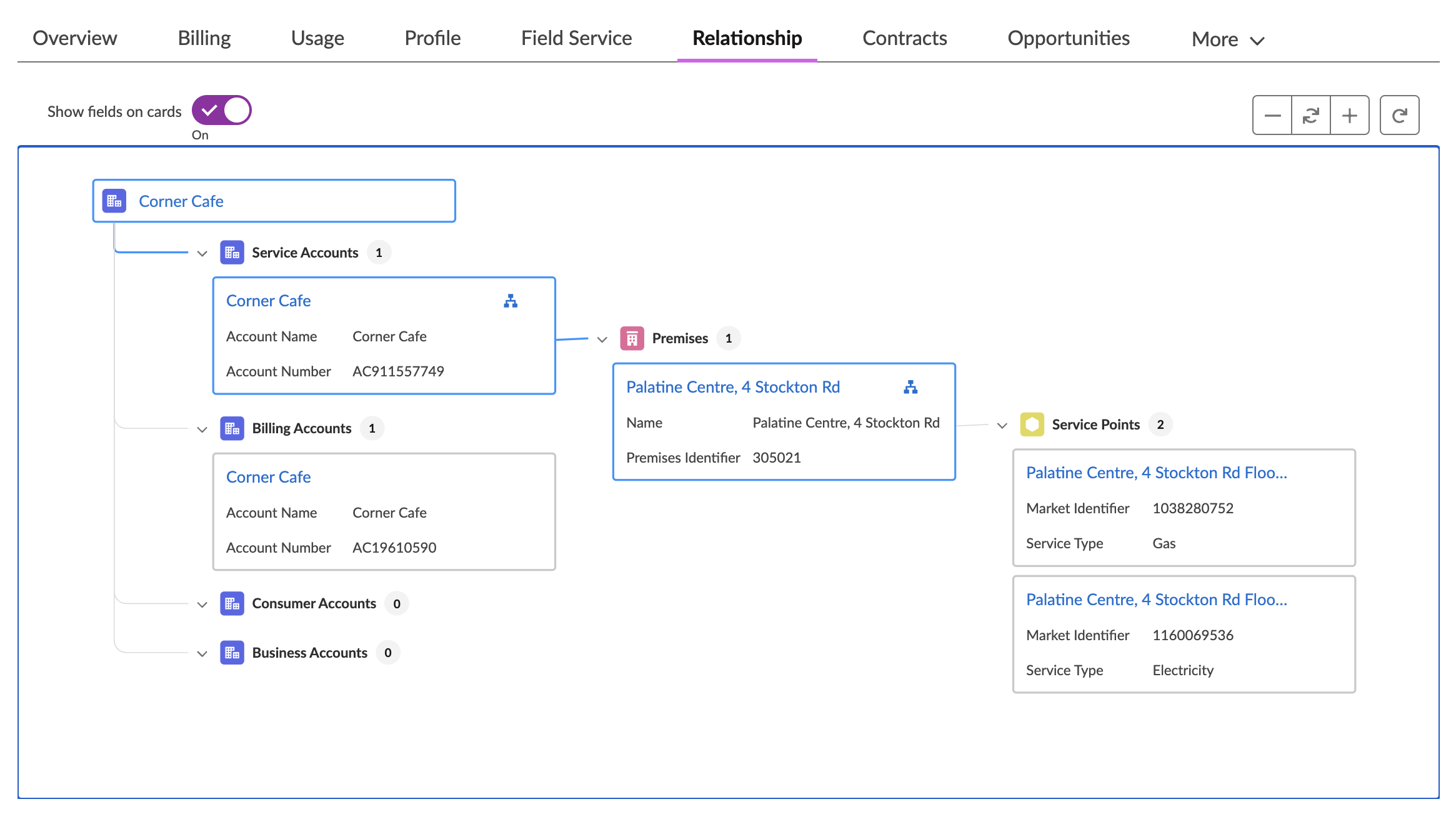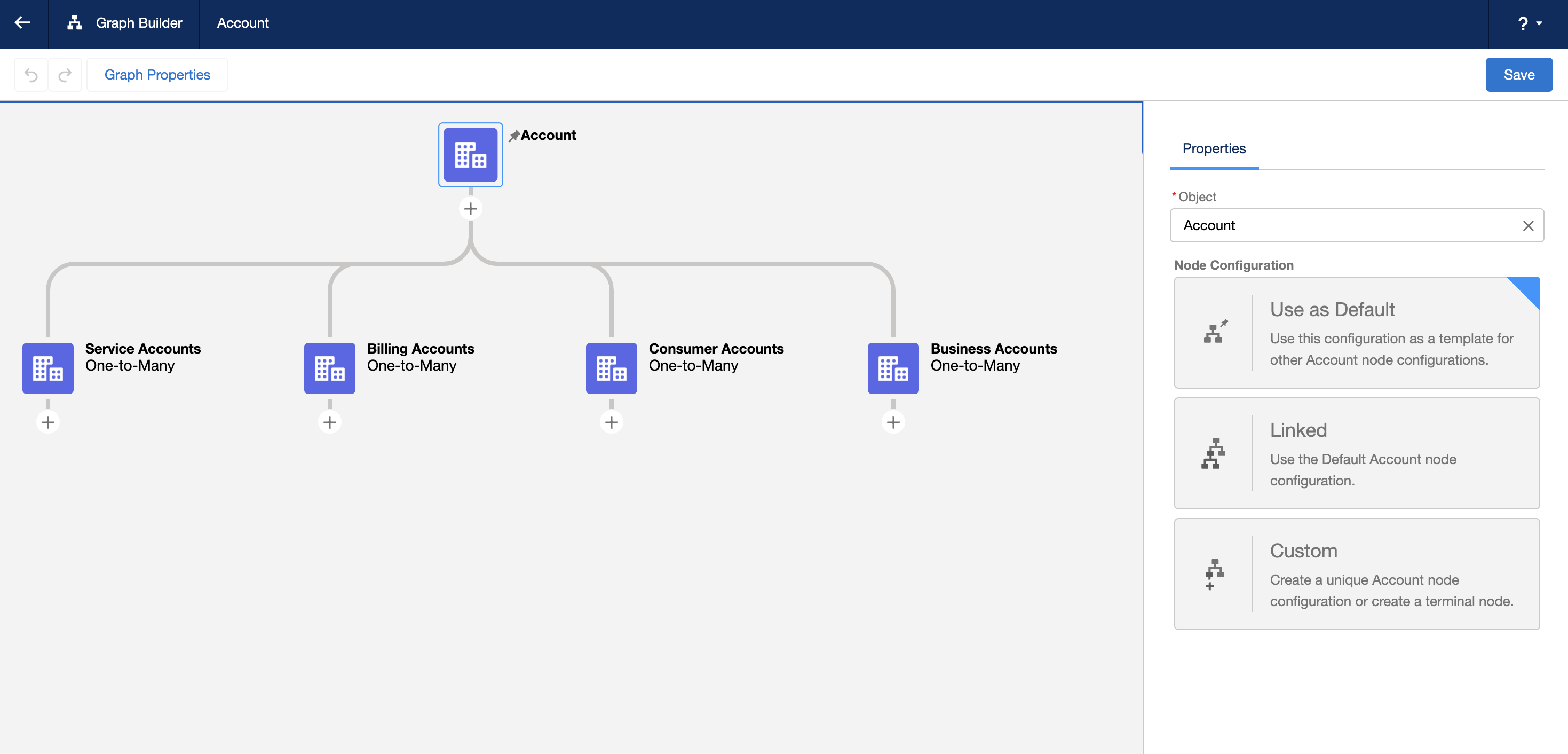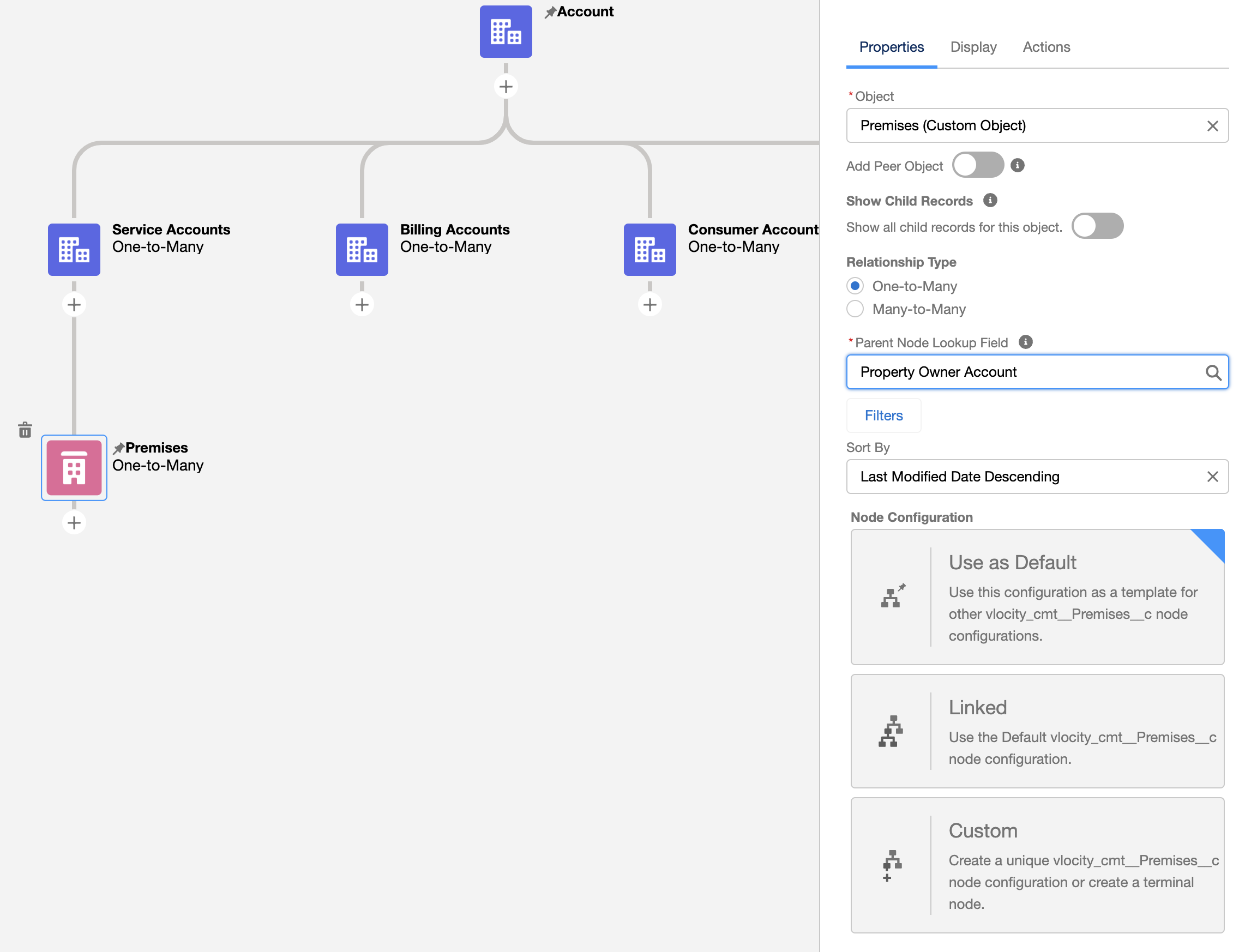Actionable Relationship Center - Service Account
Actionable Relationship Center - Service Account
According to the help docs provides an easy to navigate graph. To get orientated start by looking at the Trailhead for Actionable Relationship Center. While ARC originates from Financial Services Cloud it is available as part of Energy & Utilities Cloud currently.
A working knowledge of the Energy & Utilities data model will be very helpful for this article.
Why should I care about ARC?
With a few simple configurations a lot of functionality can be added to Service Account.
- Add a trigger to create required data structure
- Add Premises Object
- Add Service Point Object
Express - Agent Console
A sample graph is provided with the Contact Center Console. This graph includes a single level of hierarchy on account object. It does not navigate through Premises or Service Point. The fact that the package data model relies heavily on a hierarchy makes it an excellent candidate for a relationship graph. It would be more powerful it is extended to Premises and Service Point as well.
Service Account Data Model
The issue with the Energy & Utilities data model is that the Account object has a lookup relationship to the Premises object.
classDiagram
Service Account --|> Premises : Premises Lookup
<<Object>> Service Account
Service Account : Premises
Service Point A --|> Premises : Lookup
<<Object>> Premises
Premises : Property Owner Account
Premises --|> Service Account : Property Owner Lookup
<<Object>> Service Point A
Service Point B --|> Premises : Lookup
<<Object>> Service Point B
ARC cannot model this. There is also a field that references Account from the Premises object called Property Owner Account. For a deployment a custom field may be a better option to use but we will use this field as it exists already and is not commonly used.
Trigger
The plan of attack here is to create a trigger that will populate the Property Owner Account on Premises when a Service Account is created that points to the Premises. The sequence here is important as Premises is created before Service Account as Service Account has a lookup to Premises.
This relationship matters as it is used in several console Flex Card components as well as some Multi Site CPQ logic. The goal here is have the data model be used as normal but use the trigger to add this lookup to account in order to allow Premises to be configured in ARC.
Note that this trigger can very likely be improved. The trigger itself is not the point of the exercise, it is more about the data pattern required for ARC to work in this scenario.
1
2
3
4
5
6
7
8
9
10
11
12
13
14
15
16
17
18
19
20
21
22
23
24
25
26
27
28
29
30
31
32
33
34
35
36
37
38
39
40
41
42
43
44
trigger UpdatePremises on Account (after insert, after update) {
// Map to hold record type names and their corresponding ids
Map<String, Id> recordTypeMap = new Map<String, Id>();
// Query for all Record Types and populate the map
for(RecordType rt : [SELECT Id, Name FROM RecordType WHERE SObjectType = 'Account']) {
recordTypeMap.put(rt.Name, rt.Id);
}
// Check if 'Service Account' record type exists in the map
if(recordTypeMap.containsKey('Service')) {
Id serviceAccountRecordTypeId = recordTypeMap.get('Service');
// List to hold Premises records to be updated
List<vlocity_cmt__Premises__c> premisesToUpdate = new List<vlocity_cmt__Premises__c >();
// Iterate over the Trigger.new list to process new or updated Account records
for(Account acc : Trigger.new) {
// Check if the Account record type is 'Service Account'
if(acc.RecordTypeId == serviceAccountRecordTypeId) {
// Query for the related Premises records
List<vlocity_cmt__Premises__c> relatedPremises = [SELECT Id, vlocity_cmt__PropertyOwnerAccountId__c
FROM vlocity_cmt__Premises__c
WHERE Id = :acc.vlocity_cmt__PremisesId__c ];
// Update the related Premises records
for(vlocity_cmt__Premises__c prem : relatedPremises) {
prem.vlocity_cmt__PropertyOwnerAccountId__c = acc.Id;
premisesToUpdate.add(prem);
}
}
}
// Update the Premises records
if(!premisesToUpdate.isEmpty()) {
update premisesToUpdate;
}
} else {
System.debug('Record type "Service" not found.');
}
}
After creating this trigger. Test that is works by changing any Service Account record that has an associated Premises (for example, Corner Cafe in the trial org).
Premises Object
Now then, let’s start to extent the default graph shipped in Express Orgs.
Note that you could create a new one we are just saving some clicks by extending what we have
Navigate to Setup > Actionable Relationship Center > sfiEnergyConsoleInteractionGraph and select ‘edit’ from the inline dropdown menu.
On Service Accounts node click the + sign. For Object, type in Premises and for Parent Node Lookup Field select ‘Property Owner Account’. Leave the rest of the settings as default.
Select the fields to show on the Display tab of the Premises object (in this case, Name and Premises Identifier).
Service Point Object
Next let’s add service point. Click on the + sign below the Premises object. Type in ‘Service Point’ for the Object and select ‘Premises’ as the Parent Node Lookup Field.
 ARC Adding Service Point Object
ARC Adding Service Point Object
Select the fields to show on the Display tab of the Service Point object (in this case, Market Identifier and Service Type).
Preview the updated graph by navigating to the Corner Cafe account record in the ‘Energy Utility Console’ app.
 ARC Adding Service Point Object
ARC Adding Service Point Object
Wrap up
Note that a custom field could be used for the lookup from Premises to Account is Property Owner Account is being used already. In general it is more likely that Account Contact Relationship or Account Relationship would be used to cover scenarios where Property Owner Account would be used.
Later posts will add objects to other records (e.g. Billing Account payment methods), add actions to objects (e.g. meter read from service point) and Flex Cards… To view Actionable Relationship Center posts filter by sub category ‘ARC’.
Here is a repo containing all the config created in this post.


Comments powered by Disqus.